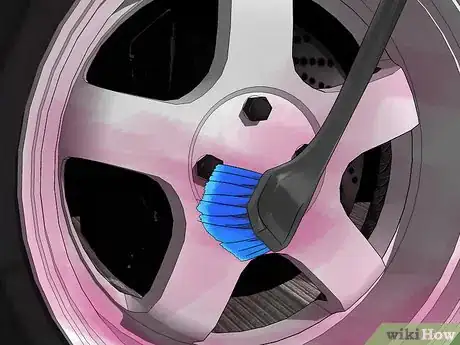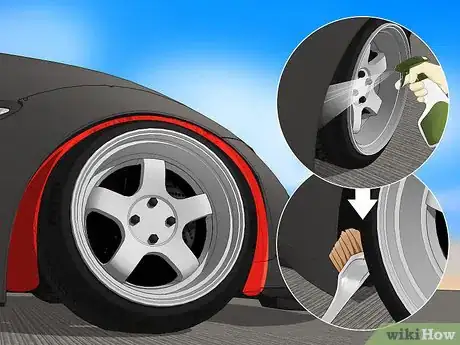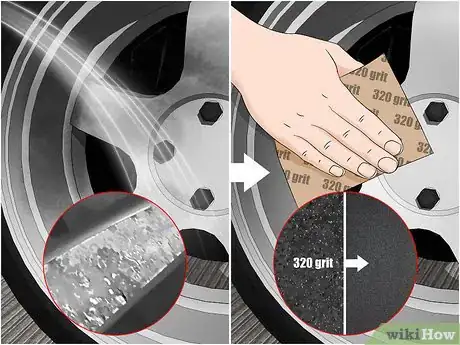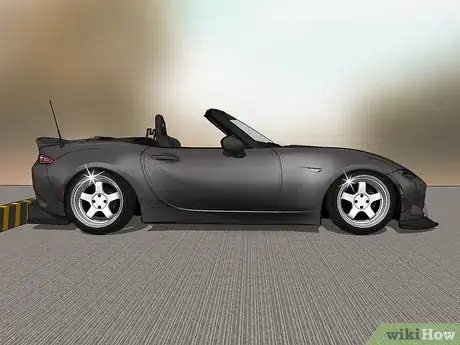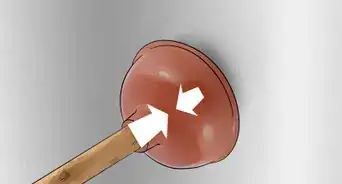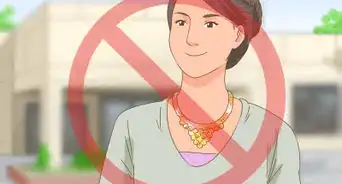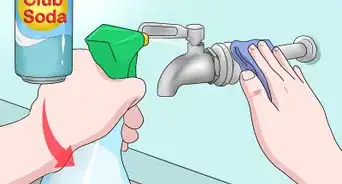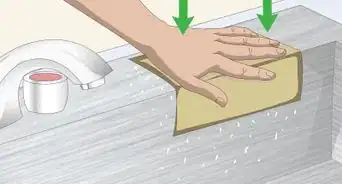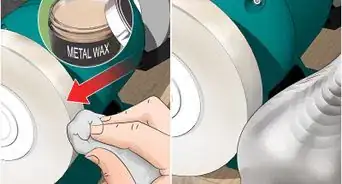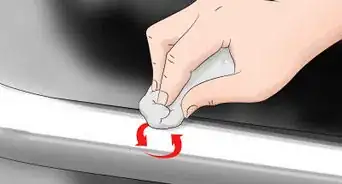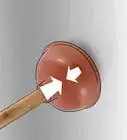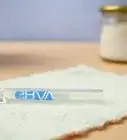This article was co-authored by Chad Zani. Chad Zani is the Director of Franchising at Detail Garage, an automotive detailing company with locations around the U.S. and Sweden. Chad is based in the Los Angeles, California area and uses his passion for auto detailing to teach others how to do so as he grows his company nationwide.
This article has been viewed 146,795 times.
Aluminum wheels naturally oxidize over time, leaving them susceptible to dirt buildup and damage and in need of a good cleaning. Other buildups, such as corrosive brake dust, can compromise the integrity of your wheels as well. Cleaning your aluminum wheels, however, is relatively simple. You'll need water, an aluminum wheel cleaning product, and a soft bristle brush. After gathering the materials and prepping your car for cleaning, you can get to work removing surface debris and oxidation and finish with a polish to give your wheels that just-bought shine.
Steps
Removing Surface Debris
-
1Park your car on a flat surface. Chock the wheels of your car with a piece of wood to ensure it does not roll while you’re cleaning. Park out of the sun to prevent cleaners from drying too fast, which can decrease their peroxiding power and cause spotting.[1]
-
2Test the aluminum for a coating. If you are unsure whether your aluminum wheels are coated or uncoated, apply a small amount of polish to an out-of-sight spot on the wheel with a clean, microfiber cloth or a polishing pad. Oxidized aluminum will wipe off black. If there is no black residue, your wheels are likely coated.[2]
- Coated wheels should be cleaned similarly to bare aluminum, but only with a clear coat cleaner, like Griot’s Garage Wheel Cleaner or Pinnacle Clear Coat Safe Wheel Cleaner.[3]
Advertisement -
3Wash the wheels with water. Clean and polish wheels one at a time. Remove as much buildup, dirt, and brake dust as you can from your tires with a powerful stream of water. Rinse all parts of the wheel and the wheel well thoroughly.
- Only clean oxidation from your wheels before washing your car. It’s likely that while cleaning your wheels dirtiness will spread to your car.
- Dirt and brake dust have a tendency to build up around or between spokes, brake calipers, and even behind the wheel. Rinse these areas carefully.
- A Fireman’s Nozzle can improve the stream of normal hoses, though power washers will be most effective at rinsing wheels.[4]
Removing Oxidation
-
1Apply aluminum wheel cleaner to the wheel. Acidic cleaners may cause spots to form on aluminum wheels. Spray the wheel you have just rinsed with aluminum cleaner. Be sure to cover all areas of the wheel with cleaner thoroughly.
- Many kinds of aluminum cleaner and polish are skin and eye irritants. Wear rubber gloves and protective eyewear while cleaning and polishing.[5]
- Two common, non-acidic aluminum wheel cleaners include SONAX Wheel Cleaner Full Effect and Detailer’s Pro Series Wheel Cleaner.
- Certain cleaners may require a special procedure to be effective. Always follow the label directions on the cleaner for best results.[6]
-
2Brush all surfaces of the wheel clean. Only use a soft bristle brush on your wheels, no matter how dirty they are. Use the brush to work the soap on the wheel into a lather. After cleaning the front, clean the inner parts of the wheel by reaching through the spokes.[7]
- Stiff bristle brushes can create scratches or clouding in the surface of your wheels. These marks may be difficult to polish away.
- The contours and inner parts of lug nuts collect corrosive brake dust. Use a small, soft bristle, detailing brush or lug nut brush to clean around the nuts and inside their holes.
- Keep the wheel wet while brushing it. The presence of water will help prevent scratches. Additionally, cleaner that dries on the wheel will likely result in a spotted finish.[8]
-
3Scrub out the wheel wells. The area of the frame surrounding the tire is the wheel or fender well. Re-wet this area if necessary. Apply all-purpose car exterior cleaner to a stiff bristle brush. Firmly scrub out the wheel well completely.
- Because the buildup on wheel wells is usually stubborn, this part of the car is designed to be sturdy and resilient. Scrub the wheel well vigorously.
- Keep your brushes separate. Do not use your stiff well brush on your wheels, nor should you use your soft wheel brush on the wells.
- Keep the wheel wet while brushing it. The presence of water will help prevent scratches and a spotted finish.[9]
-
4Rinse the wheel thoroughly. Use your hose or power washer to completely clean soap from all areas of the wheel. Start with the wheel well, as this area will likely splash grime on your wheel while rinsing. Pay close attention to spokes and lug nuts. Flush soap from lug nut holes.
-
5Dry the cleaned wheels with a microfiber cloth. Allowing your wheels to air dry will likely result in spots. To protect the finish of your wheels, only use a soft microfiber cloth. Keep wheel-drying cloths separate from others to prevent corrosive brake dust from harming more delicate parts of your car.
- After you’ve finished cleaning all your car wheels, wash your wheel drying cloths separately from other laundry or car cleaning items.[10]
-
6Use cleaning clay to remove embedded particles when necessary. No matter how many times you scrub your wheel with cleaner, embedded particles will likely remain. Use cleaning clay after you’ve cleaned the wheel but before it has been polished or waxed. Though brands may vary, generally, to apply the clay:
- Spray your wheel with a clay lubricant. This may have come with your clay, or it may need to be bought separately.
- Shape about a quarter of the clay into a patty with your fingers. With moderate-light pressure, rub the clay over the wheel’s surfaces. Take care to apply the clay to difficult to reach places and black spots.
- Fold the clay as it becomes dirty so that you continue to remove embedded particles with clean parts of the clay.
- Use clay lubricant and a clean, soft microfiber cloth to wipe away clay when the entire wheel has been cleaned.[11]
Polishing Aluminum Wheels
-
1Polish coated wheels lightly. Coated aluminum wheels should not have much (or any) oxidation or pitting. Only use a clear coat safe polish, like Meguiars Ultimate Polish, on clean, dry, clear coated aluminum.[12] Always follow the directions on the polish, but generally, to polish coated wheels:
- Apply the polish one wheel at a time with a microfiber cloth.
- Buff the wheel with a ball shaped power polisher polishing pad or a clean, soft microfiber cloth.
- When the polish dries or is mostly gone, use a fresh, soft microfiber cloth to wipe the wheel.[13]
EXPERT TIPChad Zani is the Director of Franchising at Detail Garage, an automotive detailing company with locations around the U.S. and Sweden. Chad is based in the Los Angeles, California area and uses his passion for auto detailing to teach others how to do so as he grows his company nationwide.Auto Detailing Expert
 Chad Zani
Chad Zani
Auto Detailing ExpertOur Expert Agrees: Instead of going for the strongest polish you can find, start with a lighter polish. You never want to do a fast fix with a heavy chemical to save time. Always start with the lightest compound and see if that does the job. If it doesn't, work your way up through the stronger polishes until the wheels look how you want.
-
2Remove heavy oxidation before polishing bare aluminum. When your wheels are heavily oxidized, you’ll need to use an aluminum polish pre-cleaner. Spray on the cleaner and allow it to sit for about 10 minutes. Brush oxidized areas where necessary. Rinse and dry the wheel well before moving on.
-
3Buff out severe pitting and oxidation by hand. Wet the metal of the wheel with water. With your coarsest (lowest grit rating) sandpaper, buff the wheel. Rinse the wheel regularly and keep it wet throughout this process. As pitting diminishes, switch to a finer grit (higher rating) paper. When the pitting is all but gone, finish with your finest grit paper.
- Depending on the amount of pitting or oxidation on your rims, you may need to replace your sandpaper several times while sanding. Severe pitting may require coarser sandpaper, like one that is 320-grit.
- A power polisher will buff wheels more efficiently and quickly. If you have a power polisher, save yourself time and effort by skipping this step and administering wheel polish instead.
-
4Administer aluminum wheel polish to the clean, dry wheel. Use an applicator, a soft, clean microfiber cloth, or a power polisher wool polishing pad to apply the polish to the wheel. Apply enough polisher for the entire wheel, or the amount directed in the instructions.
-
5Use a power polisher, if available. Activate the polisher on a slow setting and spread the polish across the wheel’s surface. After the polish is well spread, little by little increase the polisher’s speed until it reaches 3000 RPM.
- While polishing, keep the pad moving across the wheel. When the polish begins to dry or disappear, wipe the wheel surface with a clean microfiber towel.
- This process can also be done by hand. Buff polish onto wheels with a polishing pad. Polishing by hand may require considerable time and effort.
- Some polishes may have multiple stages, like those that have a general polish and a finishing polish. Apply secondary agents in the same fashion as normal polish, but use a clean pad.[14]
-
6Wipe away remaining polisher with a clean microfiber cloth. At this stage, your wheel should be looking like new. If, however, you aren’t yet happy with the condition of your wheel, repeat the polishing process. After each time polishing, wipe the wheel with a clean, soft microfiber cloth.
- For multi-stage polishes that use a fine or finishing polish, only re-polish the wheel with the finishing polish.
- If you plan on re-polishing, be sure to use new pads and cloths. Dirty or gritty polish can re transfer to your wheel or cause scratches.[15]
-
7Clean and polish the remaining wheels in this fashion. Now that your wheel is cleaned and polished, repeat this process on your remaining wheels. To prevent further oxidation, apply a wheel wax to the wheel according to its label directions.
- Wheel wax can be bought at most auto and hardware stores, as well in the automotive section of many general retailers. An application of wax will prevent dirt and break dust from building up.[16]
Expert Q&A
Did you know you can get expert answers for this article?
Unlock expert answers by supporting wikiHow
-
QuestionCan oxidized aluminum be cleaned?
 James SearsJames Sears leads the customer happiness team at Neatly, a group of cleaning gurus based in Los Angeles and Orange County, California. James and the team have nine years of experience and offer green cleaning, interior and exterior window washing, and general apartment cleaning services. He provides transformative cleaning experiences by reducing clutter and renewing your home environment. James is a Trustee Scholar at the University of Southern California.
James SearsJames Sears leads the customer happiness team at Neatly, a group of cleaning gurus based in Los Angeles and Orange County, California. James and the team have nine years of experience and offer green cleaning, interior and exterior window washing, and general apartment cleaning services. He provides transformative cleaning experiences by reducing clutter and renewing your home environment. James is a Trustee Scholar at the University of Southern California.
House Cleaning Professional
Warnings
- Although it is perfectly fine to polish your wheels by hand, a power polisher will yield the best results.⧼thumbs_response⧽
- Many kinds of aluminum cleaner and polisher are harsh and can irritate your eyes and skin. For this reason, wear protective gear, like rubber gloves and safety glasses.⧼thumbs_response⧽
Things You’ll Need
- 4-inch (10.2 cm) wool polishing pad
- All-purpose car exterior cleaner
- Aluminum cleaner
- Aluminum wheel polish (and pre-cleaner for heavy oxidation)
- Bucket
- Cleaning clay (optional)
- Hose (with spray attachment)
- Microfiber cloths (several)
- Power polisher (optional)
- Power washer (optional)
- Protective eyewear
- Rubber gloves
- Soft bristle brush
- Stiff bristle brush (long handled preferred)
- Wet sand paper (800 grit, 1500 grit, and 2000 grit; for hand polishing)
References
- ↑ http://www.autogeek.net/how-to-clean-aluminum-wheels.html
- ↑ http://www.trucktrend.com/how-to/wheels-tires/1211rv-restoring-the-shine-cleaning-aluminum-alloy-rims/
- ↑ http://www.autogeek.net/how-to-clean-clear-coat-wheels.html
- ↑ http://www.autogeek.net/how-to-clean-aluminum-wheels.html
- ↑ http://www.fourwheeler.com/how-to/wheels-tires/1611-make-swap-meet-wheels-look-new/
- ↑ http://www.autogeek.net/how-to-clean-aluminum-wheels.html
- ↑ http://www.autogeek.net/how-to-clean-aluminum-wheels.html
- ↑ http://www.autogeek.net/how-to-clean-aluminum-wheels.html
- ↑ http://www.autogeek.net/how-to-clean-aluminum-wheels.html
- ↑ http://www.autogeek.net/how-to-clean-aluminum-wheels.html
- ↑ http://www.autogeek.net/how-to-clean-aluminum-wheels.html
- ↑ http://www.fourwheeler.com/how-to/wheels-tires/1611-make-swap-meet-wheels-look-new/
- ↑ http://www.autogeek.net/how-to-clean-clear-coat-wheels.html
- ↑ http://www.autogeek.net/how-to-clean-aluminum-wheels.html
- ↑ http://www.autogeek.net/how-to-clean-aluminum-wheels.html
- ↑ http://www.autogeek.net/how-to-clean-aluminum-wheels.html
About This Article
To clean oxidized aluminum wheels, start by rinsing the wheels with water, making sure to focus on the build up around the spokes. Once you’ve removed as much dirt and brake dust as you can, spray each wheel with a non-acidic wheel cleaner, like Sonax, and use a soft bristle brush to work it into a lather on the surface of the wheels. Next, vigorously scrub the wheel wells with a stiff bristle brush and an all-purpose car cleaner to get rid of buildup. Finally, rinse the wheels thoroughly with water before drying them with a clean microfiber cloth. For tips on how to polish your aluminum wheels after you clean them, read on!




